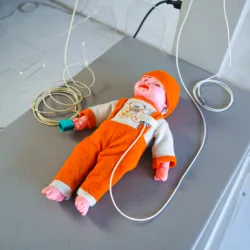Radiant heat warmer Dual sensor fix cradle
- Highly Reliable Micro-Controller
- Radiant Heat Warmer With Fix cradle
- Infrared Ceramic Type Heater
- Dual Probe – Skin and Air Probe
- 3 Mode Skin/Air / Manual Mode
Enquiry about Radiant heat warmer Dual sensor fix cradle

A “baby warmer” is a medical device designed to provide a controlled and warm environment for newborn infants, especially premature babies or those born with low birth weight. These devices are used in neonatal intensive care units (NICUs) and other healthcare settings to help maintain a baby’s body temperature, which is crucial for their overall well-being and development. Here are some key features and information about baby warmers:
- Temperature Control: Baby warmers maintain a stable and controlled temperature within a specific range to prevent hypothermia (low body temperature) in premature or sick infants. This temperature control is critical for their survival and health.
- Open Bed Design: Many baby warmers feature an open bed design that allows medical professionals to access the baby easily for medical procedures, monitoring, and care without disturbing the thermal environment.
- Radiant Heat: Baby warmers often use radiant heat, similar to the concept described in the previous response about radiant heat warmers. They emit infrared radiation to warm the baby’s skin and maintain the desired temperature.
- Humidity Control: Some models include humidity control to prevent excessive moisture loss from the baby’s skin, which can be a concern, particularly for premature infants.
- Monitoring and Alarms: Baby warmers are equipped with sensors and alarms to monitor the baby’s temperature, heart rate, and other vital signs. If these parameters deviate from the safe range, alarms will alert healthcare providers.
- Gentle Handling: The design of baby warmers typically minimizes handling and disturbance of the infant to reduce stress and discomfort.
- Portability: Some models are designed to be portable, allowing for the safe transport of infants between different care units within a hospital.
- Radiant Warmers vs. Incubators: While baby warmers provide overhead radiant heat, incubators are another type of device used for maintaining a warm environment for newborns. Incubators are enclosed, temperature-controlled chambers that surround the baby, while radiant warmers are open bed designs. The choice between these two devices depends on the baby’s condition and medical needs.
Baby warmers play a crucial role in neonatal care, especially for premature or sick infants who may struggle to regulate their body temperature. They are an essential tool in ensuring the well-being and survival of these vulnerable newborns.
Specification
- Heater output : 0-600W.
- Skin Mode Temperature Range : 32 to 38 ºC
- Air Mode Temperature Range : 32 to 38 ºC
- Manual mode for Pre-warm.
- Accuracy +/- 0.5 ºC at 30 to 40 ºC
- Power requirement 230V AC.
Be the first to review “Radiant heat warmer Dual sensor fix cradle” Cancel reply
Related products
NICU Medical Equipments
NICU Medical Equipments
NICU Medical Equipments
Pulse Oximeter
NICU Medical Equipments
























Reviews
There are no reviews yet.